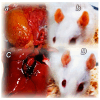Stable Gastric Pentadecapeptide BPC 157 as a Therapy and Safety Key: A Special Beneficial Pleiotropic Effect Controlling and Modulating Angiogenesis and the NO-System
- PMID: 40573323
- PMCID: PMC12195719
- DOI: 10.3390/ph18060928
Stable Gastric Pentadecapeptide BPC 157 as a Therapy and Safety Key: A Special Beneficial Pleiotropic Effect Controlling and Modulating Angiogenesis and the NO-System
Abstract
Although approached through many concepts, the pleiotropic healing issue, specifically, maintaining/reestablishing tissue integrity, remains a central challenge in pharmacology, particularly when the process is misdirected or not properly controlled. Robert and Szabo's concept of cytoprotection holds that innate cell (epithelial (Robert), endothelial (Szabo)) integrity and protection/maintenance/reestablishment in the stomach is translated to other organ therapy (cytoprotection → organoprotection) via the cytoprotection agent's effect. Therefore, we defend stable gastric pentadecapeptide BPC 157 therapy's efficacy and pleiotropic beneficial effects, along with its high safety (LD1 not achieved), against speculation of its negative impact, speculation of angiogenesis toward tumorigenesis, increased NO and eNOS, damaging free radical formation, and neurodegenerative diseases (Parkinson's disease and Alzheimer's disease). Contrarily, in wound healing and general healing capabilities, as reviewed, as a cytoprotective agent and native cytoprotection mediator, BPC 157 controls angiogenesis and the NO-system's healing functions and counteracts the pathological presentation of neurodegenerative diseases in acknowledged animal models (i.e., Parkinson's disease and Alzheimer's disease), and it presents prominent anti-tumor potential in vivo and in vitro. BPC 157 resolved cornea transparency maintenance, cornea healing "angiogenic privilege" (vs. angiogenesis/neovascularization/tumorigenesis), and it does not produce corneal neovascularization but rather opposes it. Per Folkman's concept, it demonstrates an anti-tumor effect in vivo and in vitro. BPC 157 exhibits a distinctive effect on the NO-level (increase vs. decrease), always combined with the counteraction of free radical formation, and, in mice and rats, BPC 157 therapy counteracts Parkinson's disease-like and Alzheimer's disease-like disturbances. Thus, BPC 157 therapy means targeting angiogenesis and NO's cytotoxic and damaging actions but maintaining, promoting, or recovering their essential protective functions.
Keywords: BPC 157; angiogenesis; control/modulation; nitric oxide.
Conflict of interest statement
The authors declare no conflicts of interest.
Figures




References
-
- Grubisic M.M., Strbe S., Barisic I., Balenovic D., Stambolija V., Lozic M., Ostojic S.B., Oreskovic I., Zizek H., Brcic K., et al. Stable gastric pentadecapeptide BPC 157 as a therapy of severe electrolyte disturbances in rats. Curr. Neuropharmacol. doi: 10.2174/011570159X349612241205065330. 2025, Online ahead of print. - DOI - PubMed
-
- Sikiric P., Sever M., Krezic I., Vranes H., Kalogjera L., Smoday I.M., Vukovic V., Oroz K., Coric L., Skoro M., et al. New studies with stable gastric pentadecapeptide protecting gastrointestinal tract. Significance of counteraction of vascular and multiorgan failure of occlusion/occlusion-like syndrome in cytoprotection/organoprotection. Inflammopharmacology. 2024;32:3119–3161. doi: 10.1007/s10787-024-01499-8. - DOI - PubMed
-
- Bajramagic S., Sever M., Rasic F., Staresinic M., Skrtic A., Beketic Oreskovic L., Oreskovic I., Strbe S., Loga Zec S., Hrabar J., et al. Stable gastric pentadecapeptide BPC 157 and intestinal anastomosis therapy in rats. A review. Pharmaceuticals. 2024;17:1081. doi: 10.3390/ph17081081. - DOI - PMC - PubMed
Publication types
Grants and funding
LinkOut - more resources
Full Text Sources

